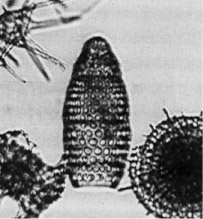 Phormostichoartus
fistula Nigrini
Phormostichoartus
fistula Nigrini Phormostichoartus
fistula Nigrini
Phormostichoartus
fistula NigriniPhormostichoartus fistula Nigrini, 1977, p.253, pl.1, figs.11-13
Shell thick-walled, smooth, subcylindrical, consisting of four segments. Cephalis approximately spherical with well-developed, poreless vertical tube lying along thorax for about half thoracic length; few subcircular pores; no apical horn. Collar stricture indistinct.
Thorax short, truncate conical with two or three transverse rows of relatively large subcircular pores. Lumbar stricture and post-lumbar strictures distinct but not pronounced. Sometimes post-lumbar stricture marked by smooth poreless band.
Abdomen annular, elongate with five to eight closely spaced transverse rows of large subcircular pores.
Fourth segment approximately same width as or narrower than abdomen; pores similar in size and shape to those on abdomen, usually in three or four transverse rows. Segment narrowing to poreless peristome, sometimes with small, poorly developed terminal teeth. In some specimens fourth segment is elongate with more pore rows, often becoming irregular in arrangement and shape (Nigrini, 1977).
Based on 15 specimens. Total length 110-190 µm; length of cephalis and thorax 36-40 µm; length of abdomen 35-53 µm; length of fourth segment 35-70 µm; maximum breadth 65-83 µm (Nigrini, 1977).
P. fistula may be distinguished from its descendant, Phormostichoartus pitomorphus (Caulet, 1986, p.850, pl.3, figs.3-4, 9-10, 12) by its greater size, larger pores and less pronounced lumbar stricture.
Rare or very rare from Theocyrtis tuberosa Zone to Spongaster pentas Zone. Eocene and Oligocene specimens usually incomplete, with fourth segment either broken or not originally developed. Characteristic vertical tube always well developed (Nigrini, 1977).
This species can be found in both tropical and temperate latitudes. Its morphotypic last appearance is a reliable and easily recognizable synchronous event.
Origin unknown; evolved into P. pitomorphus in the early Pliocene; may also be the ancestor of P. corbula.
In the Indian Ocean, Johnson et al (1989) used the upper limit of P. fistula to subdivide the Spongaster pentas Zone.